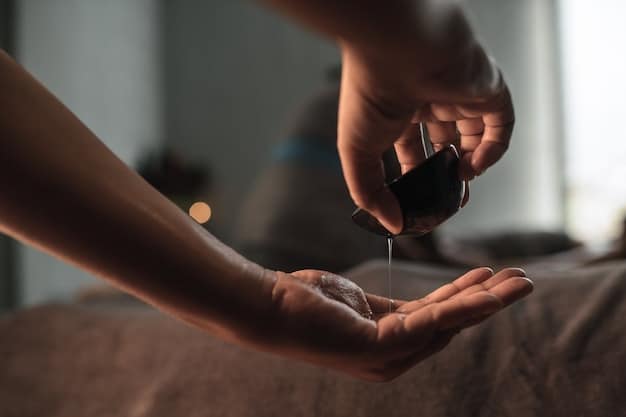Self-Care Sunday: Muscle Relief with Essential Oil Bath

Advertisements
Self-Care Sundays provide an opportunity to unwind and rejuvenate, and a relaxing bath with essential oils is a perfect way to ease muscle tension, reduce stress, and promote overall well-being. This article explores how to create the ultimate muscle-soothing bath experience with essential oils.
Advertisements
Elevate your self-care ritual with the simple indulgence of an essential oil bath. Transform your Sunday into a spa-like experience to help melt away tension and soothe sore muscles.
Creating Your Relaxing Self-Care Sunday Bath
Advertisements
A long, hot bath is more than just a way to get clean; it’s a chance to escape the stresses of daily life and nurture your body and mind. Enhancing your bath with essential oils can amplify these benefits, offering targeted relief for muscle aches and promoting relaxation.
Here’s how to create the perfect relaxing bath experience with essential oils:
Setting the Mood
Before even running the water, take some time to prepare your bathroom for relaxation. Think soft lighting, calming music, and a clutter-free environment.
Choosing the Right Essential Oils
Selecting the appropriate essential oils is crucial for muscle relief and relaxation. Some oils are better suited for these purposes than others.
- Lavender: Known for its calming and sleep-promoting properties, great for overall relaxation.
- Eucalyptus: Provides a cooling sensation and can help alleviate muscle pain and inflammation, as well as opening up airways.
- Peppermint: Offers a refreshing and invigorating effect. Relaxes muscles and promotes alertness.
- Marjoram: Excellent for soothing muscle spasms and joint pain.
Remember to always dilute essential oils properly before adding them to your bathwater. This is essential to avoiding skin irritation.
Creating a relaxing self-care bath entails a holistic approach, from setting the environment and choosing your oils to carefully diluting them and adding them to the water. Tailor this process to your own preferences and enjoy a restful, rejuvenating experience.

Essential Oils for Muscle Relief: A Deeper Dive
While we touched on some popular choices earlier, it’s worth exploring specific essential oils in more detail to understand their unique benefits and how they can contribute to muscle relief in your Self-Care Sunday bath.
Understanding the properties of different oils can help you create a blend that perfectly addresses your specific needs.
Understanding Therapeutic Properties
Each essential oil has a unique chemical composition that gives it specific therapeutic properties. These properties are what make them effective for different uses, including muscle relief, relaxation, and stress reduction.
Combining Essential Oils for Synergistic Effects
Blending essential oils can create synergistic effects, where the combined benefits are greater than the sum of their individual properties. This allows for a more customized and effective bath experience.
- Lavender and Chamomile: A classic combination for relaxation and sleep.
- Eucalyptus and Rosemary: Ideal for relieving muscle pain and congestion.
- Peppermint and Lavender: Can soothe headaches and relieve muscle tension.
Experiment with different combinations to find what works best for your body and your specific needs. Always research potential interactions before blending oils.
Exploring essential oils involves gaining a deeper knowledge of their therapeutic properties and synergistic effects. By understanding these aspects, you can customize your bath to address your body’s specific needs, enhancing the relaxation and muscle relief benefits.
Preparing Your Essential Oil Bath: Step-by-Step
The process of creating an essential oil bath is straightforward, but attention to detail is key to ensure safety and maximize benefits. Following a step-by-step approach can help you create the perfect relaxing experience.
Here’s a detailed guide to preparing your essential oil bath:
Choosing a Carrier Oil
Essential oils should never be added directly to bathwater, as they can cause skin irritation. A carrier oil helps to disperse the essential oils evenly.
Dilution Ratios and Safety Precautions
Understanding proper dilution ratios is important to avoid skin irritation. A general guideline is to use 5-10 drops of essential oil per tablespoon of carrier oil.
- For sensitive skin: Use a lower concentration of essential oils.
- For children: Consult with a healthcare professional before using essential oils.
- For pregnant women: Certain essential oils should be avoided during pregnancy.
Always perform a patch test before using a new essential oil or blend to check for any adverse reactions. If any irritation occurs, discontinue use immediately.
Preparing an essential oil bath requires careful attention to carrier oils, dilution ratios, and safety precautions. By following these steps, you can maximize the therapeutic benefits while ensuring a safe experience.

Enhancing Your Bath Experience
Beyond the essential oils themselves, there are several ways to elevate your Self-Care Sunday bath. These additions can transform a simple bath into a truly luxurious and restorative experience.
Consider these enhancements:
Adding Epsom Salts or Bath Salts
Epsom salts are known for their muscle-relaxing properties, due to their high magnesium content. Bath salts can also help to soften the skin and promote relaxation.
Creating a Spa-Like Ambiance
Creating a relaxing environment can significantly enhance the benefits of your bath use soft lighting, candles, and calming music to set a peaceful mood.
Adding Aromatherapy Elements
Consider adding aromatherapy to the bath. The gentle heat of the bath will assist with the release of the aromatherapy into the room to create a spa-like environment.
Enhancing the bath experience with additions like Epsom salts, setting a spa-like ambiance, and aromatherapy can profoundly transform a simple bath into a luxurious self-care ritual. Creating a serene and comfortable environment can enhance both physical and mental benefits.
Post-Bath Rituals for Continued Relaxation
The benefits of your essential oil bath can be extended with mindful post-bath rituals. These practices can help to prolong the feeling of relaxation and further support muscle recovery.
Here are a few ideas to incorporate into your routine:
Hydrating and Nourishing Your Skin
After your bath, your skin will be more receptive to moisturizers. Apply a nourishing lotion or oil to lock in hydration and keep your skin feeling soft and supple.
Gentle Stretching and Massage
While your muscles are relaxed from the bath, take the opportunity to gently stretch and massage them. This can help to relieve any remaining tension and improve circulation.
Relaxation Techniques
Practicing relaxation techniques like deep breathing, meditation, or progressive muscle relaxation can further enhance the effects of your bath.
Extending the bath’s calming effects can be done through hydration, gentle stretching to release all tension, and relaxation techniques like meditation. These rituals help to prolong the feeling of relaxation and support muscle recovery.
Potential Side Effects and Precautions
While essential oil baths offer numerous benefits, it’s important to be aware of potential side effects and take necessary precautions. Allergic reactions or skin irritation are possible.
Understanding these risks can help you avoid adverse reactions and enjoy your bath safely:
Allergic Reactions and Skin Sensitivity
Some people may be sensitive or allergic to essential oils, experiencing skin irritation, redness, itching, or hives. Always be cautious when trying a new essential oil.
Interactions with Medical Conditions and Medications
Certain essential oils may interact with medical conditions or medications. Consult with a healthcare professional or aromatherapist if you have any concerns.
Proper Storage and Handling of Essential Oils
Store essential oils in a cool, dark place, away from direct sunlight and heat. Keep them out of reach of children and pets.
Awareness of potential side effects, such as allergic reactions and interactions with medical conditions, is vital for safe use. Understanding and practicing proper storage can make your experience smooth and enjoyable.
| Key Point | Brief Description |
|---|---|
| 🛁 Set the Mood | Create a relaxing atmosphere with soft lighting and calming music. |
| 🌿 Choose Oils | Select essential oils like lavender, eucalyptus, or peppermint for muscle relief and relaxation. |
| 💧 Dilute Properly | Always mix essential oils with a carrier oil to prevent skin irritation. |
| 🧘 Post-Bath | Hydrate skin, stretch gently, and practice relaxation techniques. |
Frequently Asked Questions
▼
Lavender, eucalyptus, and peppermint are excellent choices. Lavender helps with relaxation, eucalyptus eases inflammation, and peppermint provides a cooling, soothing effect for sore muscles. Mix and match them based on your needs.
▼
A general guideline is 5-10 drops of essential oil per tablespoon of carrier oil. For sensitive skin, start with a lower concentration and increase gradually if needed. Always dilute properly to prevent skin irritation.
▼
Some essential oils should be avoided during pregnancy. Consult with a healthcare professional or a certified aromatherapist before using essential oils if you are pregnant to ensure both your and your baby’s safety.
▼
A carrier oil is a vegetable oil used to dilute essential oils before applying them to the skin. It helps to disperse the essential oil evenly and prevents skin irritation. Common carriers are almond, jojoba, and coconut oil.
▼
Store essential oils in a cool, dark place away from direct sunlight and heat. Keep them in tightly sealed, dark-colored glass bottles to prevent oxidation and maintain their potency over time. Store out of reach of kids and pets.
Conclusion
Creating a Self-Care Sunday bath with essential oils is a simple yet powerful way to promote relaxation, ease muscle tension, and enhance overall well-being. By following these guidelines, you can transform your bath time into a personal sanctuary for rejuvenation.





